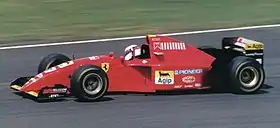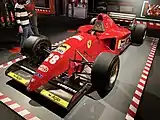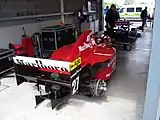 Jean Alesi driving the 412 T2 at the 1995 British Grand Prix. | |||||||||||
| Category | Formula One | ||||||||||
|---|---|---|---|---|---|---|---|---|---|---|---|
| Constructor | Ferrari | ||||||||||
| Designer(s) | John Barnard (Technical Director) Gustav Brunner (Chief Designer) Willem Toet (Head of Aerodynamics) Nicoló Petrucci (Chief Aerodynamicist) Paolo Martinelli (Engine Technical Director) Osamu Goto (Chief Engine Designer/Head of R&D) | ||||||||||
| Predecessor | 412 T1 | ||||||||||
| Successor | F310 | ||||||||||
| Technical specifications | |||||||||||
| Chassis | carbon-fibre and honeycomb composite structure | ||||||||||
| Suspension (front) | pushrod with torsion bars | ||||||||||
| Suspension (rear) | pushrod with torsion bars | ||||||||||
| Engine | Ferrari Tipo 044/1 2,997 cc (183 cu in) 3.0-liter 75° V12, rear longitudinal mounted | ||||||||||
| Transmission | Ferrari electro-hydraulic 6 speed + reverse Sequential Manual Transmission | ||||||||||
| Power | 700 to 760 PS (690 to 750 hp; 515 to 559 kW) @ 17,000 rpm[1] | ||||||||||
| Weight | 595 kg (1,312 lb) | ||||||||||
| Fuel | Agip | ||||||||||
| Tyres | Goodyear | ||||||||||
| Competition history | |||||||||||
| Notable entrants | Scuderia Ferrari | ||||||||||
| Notable drivers | 27. 28. | ||||||||||
| Debut | 1995 Brazilian Grand Prix | ||||||||||
| First win | 1995 Canadian Grand Prix | ||||||||||
| Last win | 1995 Canadian Grand Prix | ||||||||||
| Last event | 1995 Australian Grand Prix | ||||||||||
| |||||||||||
The Ferrari 412 T2 was the car with which Ferrari competed in the 1995 Formula One World Championship. Designed by John Barnard and Gustav Brunner at Shalford in the United Kingdom, the car was launched at Maranello on the 6th February, 1995.
Design
The 412 T2's design was largely influenced by major regulation changes imposed by the FIA after the tragic events during the year before: the V12 engine was reduced from 3.5 to 3.0 litre, while new side protection structures were added around the driver's helmet.
Despite concurrent work on the future V10 unit, the engine was 20lb lighter than in 1994 due to use of steel rather than cast iron, fuel capacity was reduced to 125 litres and as a consequence the engine could be mounted further forward. The exhausts were initially inserted through the rear diffuser, however this was changed mid season. The gearbox was again mounted to the block in transverse, improving rear-end weight distribution.
Aerodynamics were revised with larger and more complex bargeboards, while the front and rear wings were also modified to reduce downforce according to the new regulations. In opposition to the majority of teams in 1995, Barnard also dropped the 'raised nose' design which Ferrari had been using for the previous three seasons.
 412 T2 at the Museo Ferrari
412 T2 at the Museo Ferrari
 Ferrari 412 T2 at Donington Park in 2007
Ferrari 412 T2 at Donington Park in 2007
Season performance
This car proved to be a progressive step ahead compared from the previous year's 412 T1, but due to reliability woes and the continued dominance of the Renault RS7 V10 engine it was still not able to bring Ferrari back into the fight for the title.
Results at the start of the season were promising, with podiums for both drivers as the car was established as a frontrunner. At Imola, Berger started on the front row and went on to set the fastest lap, leading the race before stalling at the pitstops. Jean Alesi won an emotional first race for both driver and chassis at the Canadian Grand Prix, giving Ferrari the lead in the constructors world championship at that point in the season.
At the high speed circuit of Spa at the Belgian Grand Prix, the Ferraris locked out the front row of the grid and hopes were high for a title challenge. However, both cars were out with reliability issues by the halfway point, Alesi having again been leading. The disappointment continued at the Italian Grand Prix, where the Ferraris were running a commanding first and second following the pitstops. However, Berger suffered a bizarre retirement when a TV camera on Alesi's rear wing flew off and destroyed Berger's suspension. Alesi looked set to win his second Grand Prix but subsequently retired with a wheel bearing failure with just 8 laps to go.
Competitiveness waned for the remainder of the season, with the highlight being Alesi's near victory at the Nurburgring, when he came within 3 laps of winning on heavily worn tyres only to be passed by a charging Schumacher on much fresher rubber. The season concluded with the car having scored 73 points in total. This placed Ferrari in third place in the Constructors' standings for 1995.
Legacy
The 412 T2 was the last Formula 1 car powered by a V12 engine (as well as the last F1 car to win a race using one), and the last Ferrari Formula One car to run on Agip fuel.
Both Alesi and Berger moved to Benetton for the 1996 season, to be replaced by Michael Schumacher and Eddie Irvine. Schumacher tested with the 412 T2 and declared the car to be "good enough to win a world championship."
The 412 T2 was replaced by the Ferrari F310 in 1996.
Complete Formula One results
(key) (results in bold indicate pole position; results in italics indicate fastest lap)
| Year | Team | Engine | Tyres | Drivers | 1 | 2 | 3 | 4 | 5 | 6 | 7 | 8 | 9 | 10 | 11 | 12 | 13 | 14 | 15 | 16 | 17 | Points | WCC |
|---|---|---|---|---|---|---|---|---|---|---|---|---|---|---|---|---|---|---|---|---|---|---|---|
| 1995 | 412 T2 | 044/1 3.0 V12 | G | BRA | ARG | SMR | ESP | MON | CAN | FRA | GBR | GER | HUN | BEL | ITA | POR | EUR | PAC | JPN | AUS | 73 | 3rd | |
| 5 | 2 | 2 | Ret | Ret | 1 | 5 | 2 | Ret | Ret | Ret | Ret | 5 | 2 | 5 | Ret | Ret | |||||||
| 3 | 6 | 3 | 3 | 3 | 11 | 12 | Ret | 3 | 3 | Ret | Ret | 4 | Ret | 4 | Ret | Ret |
Gaming
The car appears in the video games F1 2017 and F1 2018, as part of the ‘classic cars’.
This car also appears in the Android/IOS game Real Racing 3 that can be unlocked by completing an optional career event called "Motorfiesta 1".
References
- ↑ "For Sale: A Ferrari 3000 (044/1) V12 Formula 1 Engine". 16 January 2021.